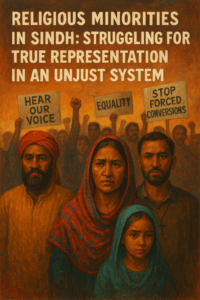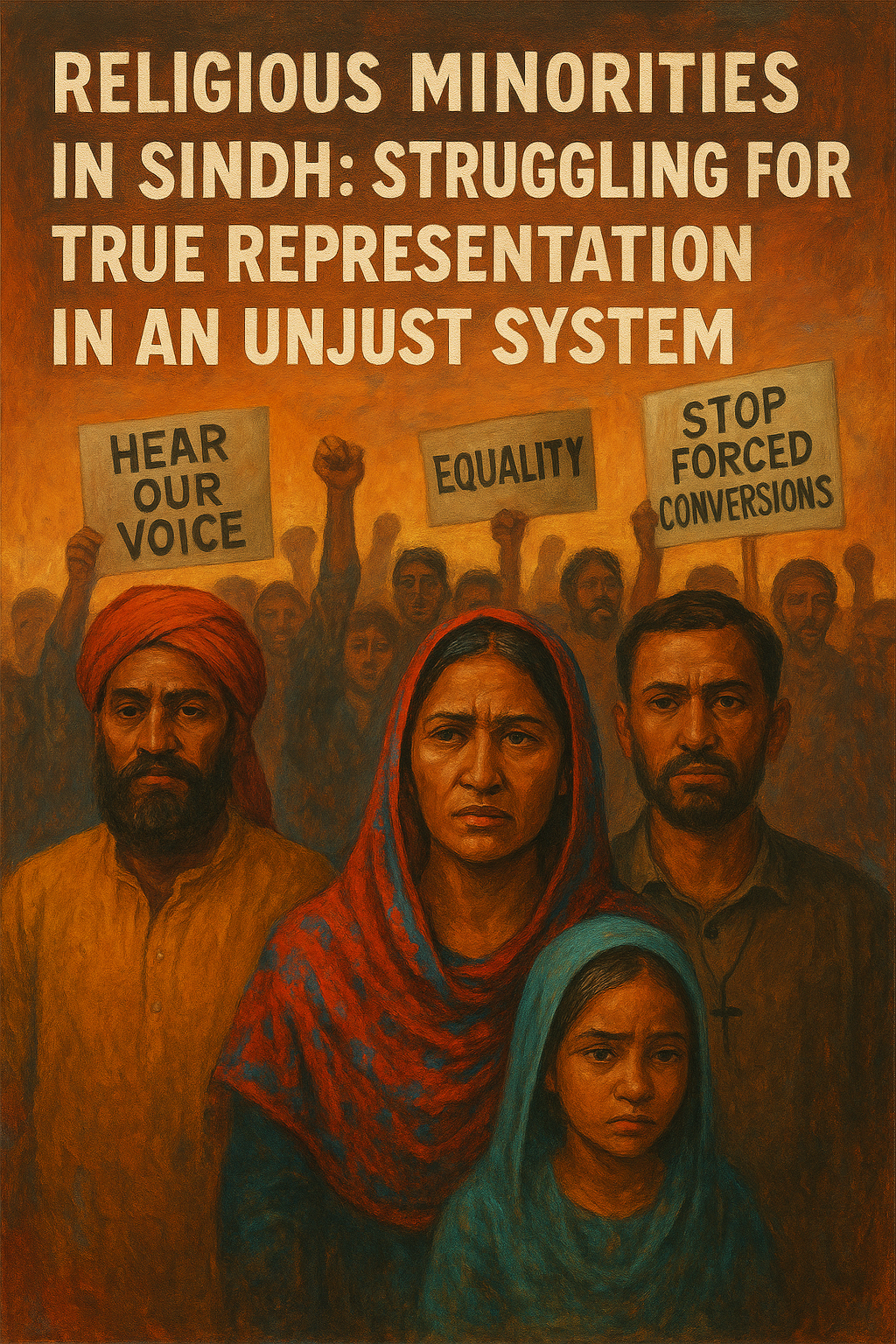One of the most pressing issues raised by minority rights organisations is the pattern of forced conversion of girls and young women from minority communities, often after abduction and coerced marriage. According to a report by the Centre for Social Justice (CSJ), between January 2021 and December 2024 at least 421 cases of forced conversion were reported nationally: 282 Hindu girls, 137 Christian girls and 2 Sikh girls. Of those, 71 % were minors. The largest share (69 %) occurred in Sindh.
A recent high‐profile case in June 2025 concerned three Hindu sisters and their cousin from Shahdadpur (Sanghar district) who were allegedly abducted and coerced into conversion. They were recovered from Karachi after joint police action.
The Human Rights Commission of Pakistan (HRCP) report launched in January 2025 further found that faith-based violence, fear of forced conversion, under-age marriage and property insecurity were driving Hindu families in Sindh to leave the province.
Despite these documented incidents, a 2021 study by the Institute of Policy Studies (IPS) concluded it found “no evidence” of forced conversion of under-age girls in Sindh during its research period — a finding contested by many civil society groups.
The discrepancy underscores the gap between field-reports, anecdotal evidence and official or academic research — and the difficulty of obtaining reliable, transparent data in these cases.
Socio-economic Marginalisation & Feudal / Political Dynamics
Many minority communities in rural Sindh are economically marginalised, often belonging to low‐income castes, working as agricultural labourers, and lacking access to quality education and healthcare. Activists note that feudal and tribal power structures dominate much of the provincial countryside, and minority groups have limited capacity to challenge them.
In addition, political parties select minority representation in reserved-seat slots, but often pick individuals who align with party priorities rather than truly represent grassroots concerns. One organiser of the Minority Rights March noted that dynastic politics, patronage networks and lack of electoral financing hinder genuine minority empowerment.
For example, land‐grabs of minority families and seizure of property are reported frequently, especially in areas where law‐enforcement is weak. A march in July 2025 in Mirpurkhas decried both forced conversions of Hindu women and corporate farmland expansion in staunchly Hindu-minority regions of Sindh.
Census, Demographics & Scope
Accurate data on minority populations and their conditions remain elusive. The Pakistan Bureau of Statistics in 2023 estimated the minority population in Sindh at around 5.47 million, of which Hindus constituted the largest group (~3.57 million), followed by scheduled castes (~1.33 million) and Christians (~547,000). (Note: these numbers were provided by the user and could not be independently verified.)
Regardless of exact figures, the HRCP study noted that Hindus make up about 8.8 % of Sindh’s population and the province remains the largest home of non-Muslim minorities in Pakistan.
Legislative Gaps & Enforcement Deficits
From a legal‐policy perspective, the problems are twofold: first, the absence of specific legislation addressing forced conversion; second, weak enforcement of existing child-marriage, abduction, marriage‐age and conversion laws.
While two bills addressing forced conversions have been tabled in the provincial assembly (Sindh) and federal level (Prohibition of Forced Conversions Bill, 2021), none have been passed into effective law. Meanwhile, laws such as the Child Marriage Restraint Act setting age-limits for marriage exist but are poorly implemented in many rural areas.
As the CSJ report states: “The relative ease and impunity with which minority women are kidnapped, forcibly converted to Islam, and unlawfully married to Muslim men is attributable to several systemic factors … the neglectful, complicit and even hostile attitudes of the police, medical authorities and judicial officers put the aggrieved party at a disadvantage.”
What’s Needed: Reform Agenda
Voices from civil society and minority communities themselves outline the following key reform measures:
-
Transparent nomination and election of minority representatives for reserved seats, including quotas for under-privileged sub-communities.
-
Electoral reforms to lower barriers for minority candidates in general seats (campaign funding, security, anti-discrimination safeguards).
-
Enactment of dedicated legislation outlawing forced conversion, with clear protections for minors, consents, and independent oversight.
-
Strengthening of law-enforcement, judicial and child-welfare mechanisms in hotspots (rural Sindh districts such as Mirpur Khas, Ghotki, Sanghar) where abductions and conversions are repeatedly reported.
-
Socio-economic empowerment of minority communities: improved access to education, healthcare, skill development, land-rights and employment quotas implemented in good faith.
-
Regular, disaggregated data-gathering, monitoring and reporting on minority rights incidents (e.g., abduction/forced conversion, land-grabs, migration) to improve transparency and accountability.
Conclusion
In Sindh in 2025, religious minorities remain caught in a precarious position: formally protected by the constitution, yet practically marginalized in terms of political voice, economic opportunity, and physical security. The phenomenon of forced conversion — particularly of young girls — remains a flashpoint of contention. While the official numbers vary and contested, local civil society documentation points to a persistent and systemic pattern.
Change will not come solely by passing laws: it will require political will, grassroots empowerment, structural reform and vigilant monitoring. Without these, representation will remain symbolic, and the realisation of minority rights will stay elusive in the face of entrenched feudal-political structures and weak institutional safeguards.

For more updates and detailed coverage of this case and other issues affecting the Hindu and Sindhi communities in Sindh, Pakistan, stay tuned to Sindh Renaissance.






